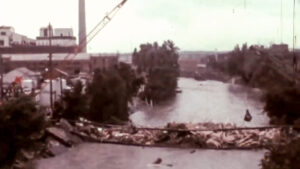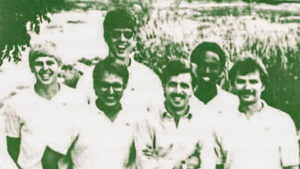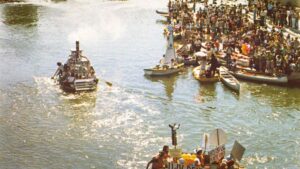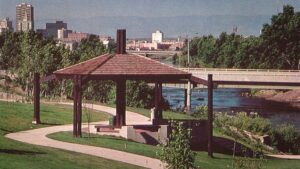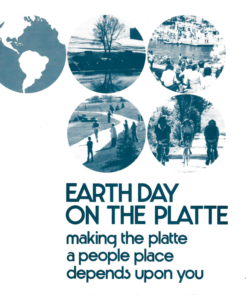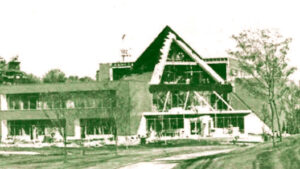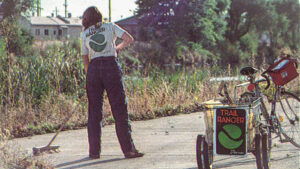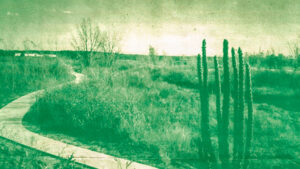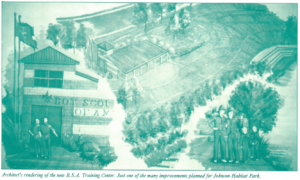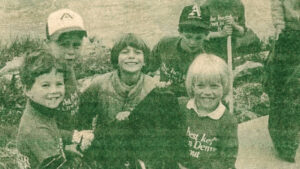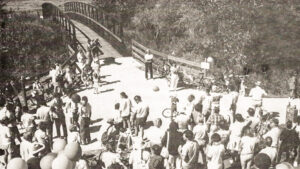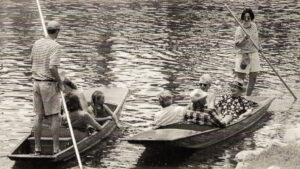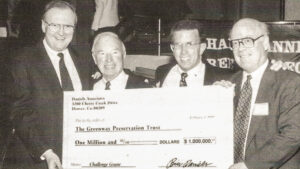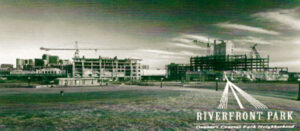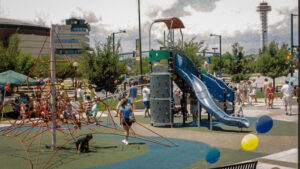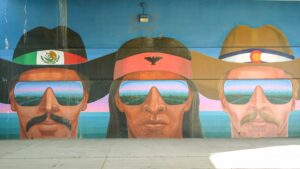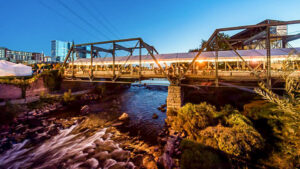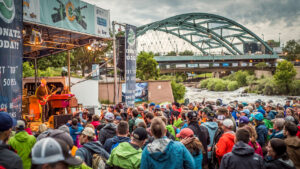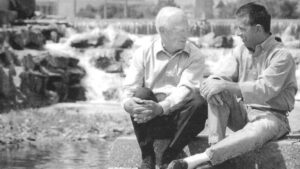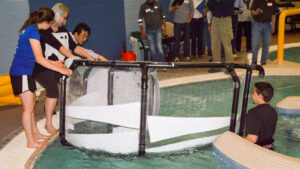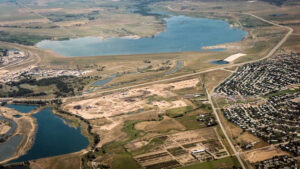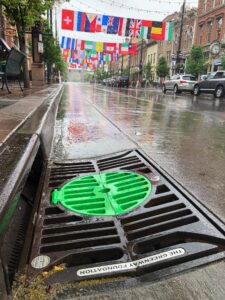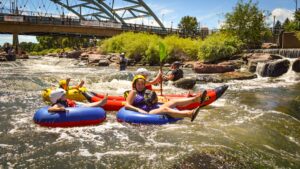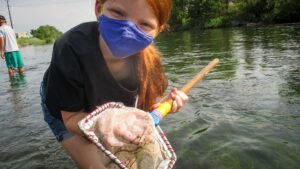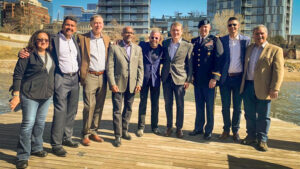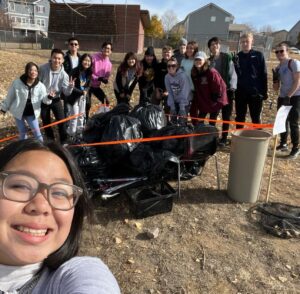Greenway & the River:
Our Shared History
The river has been the heart of Denver since before we were Denver. Our waterway weaves through our city and through our history, forever linked with our fortunes and our future.
Confluence
The confluence of the South Platte River and Cherry Creek is known as the official birthplace of Denver. Decades before settlers arrived and incorporated the towns of Denver and Aururia in 1858, indigenous people resided along the two rivers during the winter months.
In 1976, the PRDC evolves into The Greenway Foundation (TGF), a 501(c)3 non-profit focused on stewarding public and private contributions towards TGF’s mission to revitalize, restore, and reclaim the South Platte River. The vision is an environmental, recreational, cultural, scientific, and historical amenity for the City of Denver and its citizens.
1980-1981
TGF celebrates South Platte River Week in honor of the 10th Anniversary of Earth Day and initiates the Greenway River Ranger youth employment program.
A book by Joe Shoemaker, TGF Chairman and Leonard Stevens – Returning the Platte to the People – is written and published.
Denver celebrates the dedication of Gates-Crescent Park and the Denver Children’s Museum is able to initiate its relocation to the South Platte River within the Park. The southern section of the SPR Greenway Trail is completed. Community involvement grows with events like the inaugural Greenway Art Fest, the Concerts on the Green series, and the annual Friends of the River Award dinner.
1982-1987
TGF launches an environmental education program known as SPREE (South Platte River Environmental Education) in partnership with Denver Public Schools creating a curriculum for students of all ages. Soon thereafter, SPREE receives a significant grant to provide more environmental education opportunities. The River Ranger program grows with greater support.
1984-1987
The Denver Children’s Museum opens to the public. Construction of a new boat chute at 3rd Avenue is initiated. Overland Pond Park, adjacent to Overland Golf Course is dedicated in part through a significant grant from Colorado Federation of Garden Clubs. The Regional Greenway Project creates new interconnected trail loops along numerous tributaries of the River and improvements and extensions to the South Platte River trail continue to create opportunities to enjoy recreation.
1988-1989
TGF and REI begin a partnership for a volunteer-based river clean-up project and join with Urban Drainage & Flood Control District (UDFCD) and Volunteers for Outdoor Colorado (VOC) to initiate multi-faceted projects along the South Platte River.
Johnson-Habitat Park gets improvements, including a training center for Denver Area Boy Scouts, and progress on Cherry Creek South Greenway continues.
1990-1991
Both SPREE and the Trail Ranger program continue to expand while the entire area celebrates the completion of Cherry Creek South Greenway in the Town of Parker. Volunteer Days along the river are bolstered by the support of Coors Brewing Company. Exciting improvements come to Overland Pond Park, bringing better and healthier fishing conditions.
TGF joins forces with the Denver Rail Heritage Society to bring a historic trolley to the west bank of the South Platte River in the heart of Denver, providing a fun, educational experience to citizens of all ages.
1996-2000
TGF, in partnership with Mayor Wellington Webb, launches “Punt the Creek”, which later is evolved/re-named as “Venice on the Creek” – bringing a tourism boating attraction to Cherry Creek in Lower Downtown.
Mayor Webb announces the formation of the South Platte River Commission stating that his administration’s top priority in 1996 is the river.
Work continues on waterway and park projects throughout the Metro Denver area and beyond. Colorado’s Ocean Journey, now Downtown Denver Aquarium launches its goal of being located on the river. The Platte River Trolley celebrates its 10th Anniversary.
1996-2000
The Greenway Preservation Trust campaign launches to provide increased long-term financial sustainability for TGF – co-chaired by former U.S. Senator Bill Armstrong and former State Representative Morgan Smith.
Confluence Park’s Shoemaker Plaza receives an upgrade and plans get underway for the Denver Skate Park. Mayor Wellington Webb receives the 2000 Greenway Foundation Friend of the River Award.
2001-2005
Downtown partners complete and celebrate improvements along the river in central Denver. New park and open space opportunities expand—including Commons Park, City of Cuernavaca Park, Centennial Gardens and adjacent residential and commercial development projects.
Cherry Creek South Greenway continues to progress. The Denver Skate Park is completed and the Downtown Children’s Playground project is launched. TGF proudly receives the Rudy Bruner Silver Medal Award for its three-decade efforts to reclaim the South Platte River watershed.
2006-2010
The dream for the Downtown Children’s Playground is realized.
New goals include the Chatfield Reservoir Reallocation Project with a goal to increase the ability to store additional water for both municipal and environmental benefits. CityWild partners with TGF to engage youth through rafting and community efforts connected to the River. Partnerships with Art Students’ League bring Confluence Concerts and Art on the River. The River Vision Implementation Plan is created and endorsed through a Proclamation by Denver City Council. Cherry Creek Stewardship Partners joins with TGF to further solidify its efforts. TGF initiates a visioning plan for Westerly Creek in Denver. The Mile High Mile event launches with a strong focus on youth participation.
2009-2011
Over 80 kindergarten-fifth graders help local artist Emanuel Martinez create the first three panels of the “Confluent People” Mural along Little Raven Boulevard underneath the Speer Boulevard overpass. Subsequently, Mr. Martinez creates a mural of Chief Little Raven along the walls of Cherry Creek near Confluence Park, This mural commemorates the history of the indigenous people who lived along the South Platte River and Cherry Creek. This mural represents Chief Little Raven’s advocation for peace amongst all peoples.
2011-2015
In 2011, TGF hosted a new signature event – Gala on the Bridge – located on the 19th Historic Bridge. An increased focus on improving the quality of the stream flow in the watershed launches PURE (Protect our Urban River Environment). Community volunteer events increase and SPREE continues to expand both during the academic year as well as summer camps involving high school aged River Rangers as well as weekend family-focused events. Art on the River, in partnership with Art Students League, engages artists from around the Metro Denver community to create works of art celebrating the South Platte River.
2011-2015
The first South Platte RiverFest brings people from all backgrounds together at Confluence Park. The Greenway Leadership Corp (GLC) begins work helping high school students learn more about the environment and become active community members. The Friends of Greenway (FrOG) recurring donation campaign launches to provide additional ways to support the work of The Greenway Foundation.
TGF celebrates its 40th anniversary on June 16, 2014, and the Reception on the River fundraising event celebrates its 10th anniversary. TGF continues to partner in the creation of new Riverside improvements including Grant Frontier Park, Pasquinels Landing, Overland River Corridor, Johnson-Habitat Park and Confluence Park.
Two United States Army Corps of Engineers (USACE) project studies hit full stride, with a shared goal of benefitting over nine miles of the South Platte River in Denver as well as two of the river’s tributaries – Harvard and Weir Gulches. The Clear Creek Greenway Master Plan focuses on the 14 miles of the Creek in Clear Creek County.
2016-2020
The final phase of the Downtown Children’s Playground is completed and named for Paul and Carol Ann Rothman – LoDo residents and the signature advocates and supporters of the DCP.
Four exciting new park/plaza projects along the River become reality: River North Park, River North Promenade, Globeville Landing and Heron Pond/Carpio-Sanguinette. TGF engages with the National Western Center project to re-imagine this historic riverside property directly along the river.
The Chatfield Reallocation Project is completed and initial water storage opportunities begin. TGF and Denver Water, along with 18 other partners, obtain the needed funding for the final amount of the Chatfield Reservoir Environmental Pool.
2016-2020
TGF combines efforts with Frog Creek Partners to promote the installation of gutter bins in stormwater collection devices throughout Colorado which prevent over 90% of solid waste and over 50% of liquid waste from entering stormwater systems, reducing waste dumped into the South Platte watershed.
Denver Urban Waterways Study is officially authorized by Congress and the President in December of 2020. TGF, the City and County of Denver and the Mile High Flood District join forces to create the City’s first One Water Plan.
TGF welcomes the return of in-person SPREE and community event programming after a pause during the COVID-19 pandemic. Efforts begin to pursue funding for the Denver Urban Waterway Projects. TGF celebrates the 10th Anniversary of Gala on the Bridge.
TGF is contracted to oversee three significant Colorado waterway visioning projects—Purgatoire River in Trinidad, Fountain and Monument Creeks in Colorado Springs, and the South Platte River in Adams County.
After 14 years of engagement with Adams County, the City & County of Denver, the Mile High Flood District and the United States Army Corps of Engineers (USACE), Denver receives over $350 Million of funding from USACE for three EcoSystem Restoration projects along Denver’s South Platte River and a Flood Protection/Containment project along Weir Gulch in west Denver, the single largest appropriation for Denver’s urban waterways in the City’s history. Efforts begin to pursue an additional $150 Million of non-federal based funding to match this unprecedented federal government based appropriation.
TGF partners with the Grassroots Leadership Opportunities (GLO) Ambassadors Program to revitalize efforts in community outreach. Now working together under TGF’s guidance and domain, GLO begins efforts in two new community-based projects: developments to the High Line Canal in the Green Valley Ranch community and youth-based outreach in Adams County, the first of three USACE EcoSystem Restoration projects.
Parks
Gates Crescent Park
Overland Pond Park
Cherry Creek South Greenway
Milstein Park
Annual Reports
Our annual reports provide an in-depth look at The Greenway Foundation’s history. All reports and newsletters are available for download on our website. Dive deeper into our projects and history. If you still want to know more, please contact us or email info@greenwayfoundation.org.

